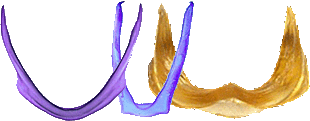Opisthoteuthidae
Michael Vecchione, Katharina M. Mangold (1922-2003), and Richard E. Young- Cirroctopus Naef, 1923
- Grimpoteuthis Robson, 1932
- Luteuthis O'Shea, 1999
- Opisthoteuthis Verrill, 1883
Introduction
Opisthoteuthis agassizii (?) on the bottom (video frame). JSL II dive 1746; 25 April 1989; St. Vincent I.; depth = 586 m; temp. = 6.6°C (from Vecchione and Roper, 1991).
The body of these octopods is foreshortened along the anterior/posterior axis. The foreshortening is extreme in Opisthoteuthis which is known as the "flapjack" (pancake) devilfish due to its flattened appearance. The secondary web is absent. The radula is reduced or absent apparently reflecting the habit of swallowing prey whole (Aldred, et al., 1983). The cirri are short when compared to those of the Cirroteuthidae. Most opisthoteuthids alternate between sitting on the ocean floor and swimming just above it (e.g., Peyera, 1965). Opisthoteuthis swims mainly by contraction of the arm-web complex while Grimpoteuthis uses primarily powerful fin strokes to swim (Vecchione and Young, 1997). Some opisthoteuthids (species of Luteuthis and some species of Grimpoteuthis) apear, judging from their very gelatinous consistency, to be entirely pelagic. An AVI format video clip of the Opsithoteuthis shown at the right is available at Cephalopods in Action.
Characteristics
 image info
image infoOral view of arm of Grimpoteuthis bathynectes. Drawing modified from Voss and Pearcy, 1990.
 image info
image info
Left to right - Opisthoteuthis grimaldii shell (U-shaped), stained, photographed by R. Young; Cirroctopus glacialis shell (V-shaped), stained, photographed by R. Young; Luteuthis shuishi shell (W-shaped), photograph from O'Shea and Lu, 2002.
- Shape and consistency
- Anterior-posteriorly compressed (shell reaches, or nearly reaches, posterior end of body; i.e., no gelatinous extension of the body exists posterior to the shell).
- Arms and web
- Suckers and cirri extend to tips of arms.
- Primary web only.
- Web nodules present (arrow) in some genera.
- Cirri
- Cirri short (length 0.4 - 2.5 times diameter of largest sucker).
- Shell
- Simple U-, V- or W-shaped.
- Lateral wings not expanded or only slightly expanded.
- Pigmentation
- Areolar spots present (arrow) in some genera.
 image info
image infoSide view of a young Opisthoteuthis albatrossi showing areolae (arrow). Drawing modified from Sasaki, 1929.
Nomenclature
O'Shea (1999) described a new genus, Enigmatiteuthis, which he placed in his family Grimpoteuthidae. He also placed Grimpoteuthis wulkeri, G. bathynectes and G. pacifica in his new genus. Collins (in press) in his examination of the North Atlantic species of Grimpoteuthis concluded that species of Enigmatiteuthis should be placed in Grimpoteuthis (i.e., Enigmatiteuthis is a junior synonym of Grimpoteuthis).
Discussion of Phylogenetic Relationships
The systematic positions of Grimpoteuthis and Luteuthis are uncertain. Voss and Pearcy (1990) place Grimpoteuthis in the family Opisthoteuthidae and O'Shea (1999) places it in its own family. O'Shea also places Luteuthis in its own family. Collins (in press) places Luteuthis in the Opisthoteuthidae but leaves Grimpoteuthis in its own family. We have adopted a conservative approach here pending a more thorough understanding of the family.
References
Aldred, R. G., M. Nixon and J. Z. Young. 1983. Cirrothauma murrayi Chun, a finned octopod. Phil. Trans. Roy. Soc. Lond., 301: 1-54.
Nesis, K. N. 1982/87. Abridged key to the cephalopod mollusks of the world's ocean. 385+ii pp. Light and Food Industry Publishing House, Moscow. (In Russian.). Translated into English by B. S. Levitov, ed. by L. A. Burgess (1987), Cephalopods of the world. T. F. H. Publications, Neptune City, NJ, 351pp.
O'Shea, Steve. 1999. The Marine Fauna of New Zealand: Octopoda (Mollusca: Cephalopoda). NIWA Biodiversity Memoir 112: 280pp.
O'Shea, S. and C. C. Lu. 2002. A New Species of Luteuthis (Mollusca: Cephalopoda: Cirroctopoda) from the South China Sea. Zoological Studies, 4: 119-126.
Pereya, W. T. 1965. New records and observations on the flapjack devilfish Opisthoteuthis californiana Berry. Pacif. Sci., 19: 427-441.
Voss, G. L. 1988. Evolution and phylogenetic relationships of deep-sea octopods (Cirrata and Incirrata). P. 253-276. In: Clarke, M. R. and E. R. Trueman (Eds.). The Mollusca. Vol. 12. Paleontology and Neontology of Cephalopods. Academic Press, New York. 355pp.
Voss, G. L. and W. G. Pearcy (1990). Deep-water octopods (Mollusca: Cephalopoda) of the Northeastern Pacific. Proc. Calif. Acad. Sci., 47: 47-94.
Vecchione, M. and C. F.E. Roper. 1991 Cephalopods observed from submersibles in the western North Atlantic. Bull. Mar. Sci., 49(1-2):433-445.
Vecchione, M. and R. E. Young. 1997. Aspects of the functional morphology of cirrate octopods: locomotion and feeding. Vie Milieu 47(2):101-110..
About This Page
National Marine Fisheries Service
Systematics Laboratory
National Museum of Natural History
Washington, D. C. 20560
USA
Katharina M. Mangold (1922-2003)
Richard E. Young
Dept of Oceanography
University of Hawaii
Honolulu, Hawaii 96822
USA
Page copyright © 1996 and Katharina M. Mangold (1922-2003)
Citing this page:
Vecchione, Michael, Mangold (1922-2003), Katharina M., and Young, Richard E. 1996. Opisthoteuthidae . Version 01 January 1996 (under construction). http://tolweb.org/Opisthoteuthidae/20089/1996.01.01 in The Tree of Life Web Project, http://tolweb.org/






